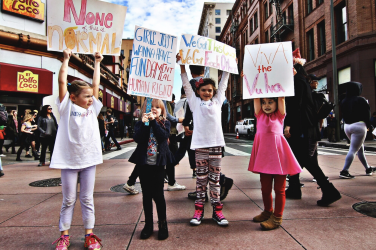To get the hype around International Women’s Day this year, you need to be aware of colour-blindness, telling statistics and the latest list of controversial films raising social tensions. Petya Yankova summarises the events which took place in the run-up to 8th March and which brought sexual and gender-based violence to the headlines.
A dress, a report and a documentary are the visual representations of Europe’s latest, and somewhat delayed, trend for publicly denouncing violence against women. Why has it taken so long to recognise a problem that statistically has an impact on the daily life of every third woman in Europe, and what is being done at the moment to reverse the terrifyingly high numbers?
It all started with a blurry image of a semi-formal dress spreading like wildfire on social media, days before International Women’s Day on 8th March. The reason for this viral success was that some online users saw an otherwise ordinary dress as black and blue, while others perceived it as white and gold. Regardless of whether this was down to screen resolution or colour-blindness, the dress became a symbol of confusion within hours.
The international organisation Salvation Army seized the opportunity to use the dress in a campaign raising awareness about domestic violence against women, playing on the phrase “black and blue” which metaphorically refers to bruises and injuries sustained by a beating.
Why is it so hard to see black and blue? One in 6 women are victims of abuse.#StopAbuseAgainstWomen pic.twitter.com/FgDdKdsMMb
— TheSalvationArmySA (@SASalvationArmy) March 6, 2015
Associated for many years with providing humanitarian assistance to veterans and homeless people, this time the Salvation Army garnered attention with the unexpected social media advertisement. The organisation’s creative PR team surely knew how to capture the trend and manipulate it for their own purposes. The power of the message – a tweet in this case – is derived from the sudden switch from a light-hearted joke to a painful social ulcer such as domestic violence. The effect was doubled as the model chosen for the picture was a woman. Releasing the image two days before International Women’s Day was another smart trick. All this combined intensified the media atmosphere before the celebration, setting the stage for discussion of the many challenges women still face today.
Although the messages come from different contexts, their almost simultaneous storming of social media and the common SBGV theme strengthened the link between them.
This year, International Women’s Day got involved with fighting sexual and gender-based violence (SBGV), not only through the now world-famous piece of clothing. A film depicting a well-known SBGV incident in India appeared at the same time as the Salvation Army #TheDress campaign. It wasn’t difficult to see the wave of public denouncement of violence against women building up when scrolling down the screen. Users notice an advertisement with an obviously bruised female model, followed closely by an unrelated film excerpt in which a man charged with rape and murder justifies his actions as supported by tradition and social norms. Although the two messages come from completely different contexts, in the minds of social media users worldwide, their almost simultaneous storming of social media and the common SBGV theme strengthened the link between them.
Scheduled for release in several countries in Northern Europe just before or on 8th March, the documentary India’s Daughter caused a stir, particularly in the United Kingdom. The film investigates a 2012 Delhi rape which became notorious, as the 23-year-old victim of a brutal attack in public died as a result of the injuries sustained. This sparked a series of protests against tolerance of SGBV in India immediately after the event, but it didn’t have such a wide international response.
Director Leslee Udwin’s documentary on the despicable incident received a great deal of attention as it brought to light deeply-ingrained cultural misconceptions about morality, gender role and the social acceptability of violence. In an interview released before the film’s premiere, one of the murderers claims the girl brought the accident upon herself by being outdoors after 9pm. As expected, this caused backlash worldwide, with thousands of readers and viewers marching on the streets or denouncing the perpetrators’ stance online. What came as a surprise, however, was the Indian Home Minister’s reaction; he threatened to sue the BBC over the documentary. The Indian government also took measures to remove it from YouTube.
All this reverberated strongly with the European audience, the outrage intensified by the advent of a day officially celebrating women’s contribution to society worldwide. What remained in the shadow were the grim results of an overview of decades of minimal progress in gender equality, published by the International Labour Organisation on the same day that the Dress Campaign began. It seems that not only the lives, but the contribution of women to society is less valued than we would like to believe. International solidarity campaigns such as #HeForShe (led by UN Goodwill Ambassador Emma Watson) and #MakeItHappen (inspired by the theme of this year’s International Women’s Day) are fighting precisely for this gender equality, which seems to remain elusive not only at work, but in other spheres of life too.

Back in Europe, the EU Fundamental Rights Agency still aims to bring about a change in SGBV findings reported this time a year ago. According to Violence Against Women: An EU-Wide Survey, released March 2014, one in three women has experienced physical and/or sexual violence as an adult. This number is too high to imagine, but it does bring into perspective the necessity of campaigns such as #HeForShe, #MakeItHappen or Salvation Army’s #TheDress. It also testifies to the strikingly harsh reality of the India’s Daughter documentary, which, to put it bluntly, is a step away from the everyday experiences of one in three women in Europe.
Cover photo: Jim Surkamp; Licence: CC BY-NC 2.0









